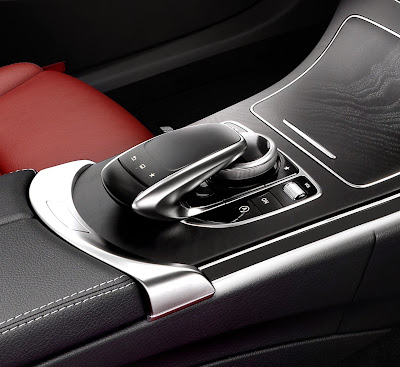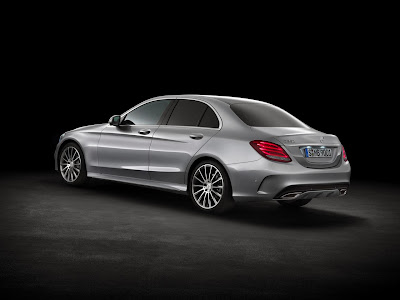The 2014 Mercedes-Benz C-Class can as standard automatically brake at up to 200km/h to avoid a collision, use just 3.9L/100km of fuel, and even show Google StreetView on its main display.
These features headline the fourth-generation premium medium car from Mercedes-Benz, which has just been revealed and is due to arrive in Australian showrooms mid next year.
Compared with the outgoing model, the new C-Class is 95mm longer (at 4686mm), 40 millimeters wider (1810mm) and scores a wheelbase extended by 80mm (2840mm).
Its slinky new body achieves an aerodynamic score of 0.24 Cd, and is constructed of around 50 per cent aluminium (compared with 10 per cent for the old 2007-13 model) that contributes to a body-in-white saving of 70kg and up to 100kg overall.
Mercedes-Benz claims fuel consumption reductions of 20 per cent across the range with no loss in performance. All cars get a seven-speed torque converter automatic transmission, and a six-speed manual on select models.
Engines from launch will include a C180 with a 1.6-litre turbocharged direct injection four-cylinder petrol delivering 115kW of power, 250Nm of torque, and 8.2 second 0-100km/h and 5.0L/100km claims.
A C200 with 2.0-litre turbo direct injection four-cylinder petrol makes 135kW, 300Nm, and posts 7.5 second 0-100km/h and 5.3L/100km claims.
The C220 BlueTEC, meanwhile, gets in addition to AdBlue treatment that dramatically reduces harmful air pollutants and denotes the latter part of the badge, a 2.2-litre turbo-diesel four-cylinder with 125kW, 400Nm, and 8.1 second 0-100km/h and 4.1L/100km claims.
Following the launch trio will be an entry-level 1.6-litre diesel with either 85-100 kW and 280-320Nm of torque depending on the state of tune. Mercedes-Benz claims this engine will give the C-Class “a leading position within its segment in terms of CO2 emissions,” although figures aren’t yet revealed.
An “advanced” version of the carry-over launch 2.2-litre diesel will also soon be revealed, in addition to a C300 Bluetec Hybrid that uses that engine and an electric motor to provide 150kW and a claimed 3.9L/100km.
A new turbo petrol engine, likely 2.0-litre in a higher state of tune, is confimred to join the range packing a BMW 328i-rivalling 175kW, while a flagship (until C63 AMG) 245kW model is also a definite, eclipsing the 225kW of the BMW 335i.
It will use either an uprated 3.5-litre V6 from the CLS-Class, which currently produces 225kW and 370Nm, or a 3.0-litre twin-turbo V6 from the E400 that produces the same power but a hefty, 335i-bashing 480Nm of torque.
While rear-wheel drive remains standard, as does a carry-over Direct Steer variable-ratio steering system, this will be the first C-Class available in all-wheel drive for right-hand-drive markets, paving the way for a future C63 AMG 4MATIC.
While fixed steel suspension is standard, three tunes of optional adaptive dampers are available – comfort, comfort-Avantgarde “with a sportier character”, and full sports suspension lowered by 15mm.
For the first time the C-Class will also be available with a flagship, optional Airmatic suspension – with Individual, Comfort, Eco, Sport and Sport+ modes – pinched from the larger E- and S-Class models.
Also stolen from the larger flagship are premium safety technology, to which the Mercedes-Benz C-Class adds further enhancements.
Adaptive Brake Assist avoids collisions from as low as 7km/h by automatically braking the car if the driver fails to brake. Standard-fitment Collision Prevention Assist Plus can brake while following traffic at speeds up to 200km/h if a collision is detected to occur.
Collisions with a stationary object will be avoided at speeds of 40km/h or less, and reduces the impact at up to 50km/h.
Distronic Plus adaptive cruise control and Enhanced Lane Keep Assist can keep the C-Class at a safe distance from the car in front when cruusing and autonomously steer the C-Class to follow cars in front in addition to lane marking.
BAS Plus reversing cross-traffic alert can also now automatically apply extra brake pressure to avoid rear collisions if the driver fails to push the pedal hard enough.
Active Parking Assist, a 360° camera including a virtual bird’s eye view, Traffic Sign Assist with Wrong-Way Alert, and Adaptive Highbeam Assist Plus that blocks out a strand of highbeam if oncoming cars are detected, are other features new to the Mercedes-Benz C-Class.
It isn’t yet clear which will be standard or optional here, except for Collision Prevention Plus and nine airbags (including dual front, front-side, rear-side, driver’s knee and full-length curtain) that will be included on all models. Three ‘lines’ are available overseas – Avantgarde, Exclusive and AMG Line.
Both outside, and inside the new and larger cabin, S-Class styling cues abound as much as the technology fitted. Internet connectivity, via Mercedes Comand online, and Mercedes-Benz Apps such as Weather, GoogleTM Local Search with StreetView and Panoramio, Destination/Route Download and Facebook will be available on the larger of two screens – 7.0-inch and 8.4-inch – and will work via a raised touchpad on the centre console.
The 2014 Mercedes-Benz C-Class will arrive in America mid next year.
SEE VIDEO:













.jpg)


























